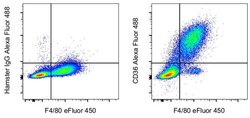Learn More
CD36 Monoclonal Antibody (HM36), Alexa Fluor™ 488, eBioscience™, Invitrogen™
Armenian Hamster Monoclonal Antibody
$278.00
Specifications
| Antigen | CD36 |
|---|---|
| Clone | HM36 |
| Applications | Flow Cytometry |
| Classification | Monoclonal |
| Conjugate | Alexa Fluor 488 |
| Catalog Number | Mfr. No. | Quantity | Price | Quantity & Availability | |||||
|---|---|---|---|---|---|---|---|---|---|
| Catalog Number | Mfr. No. | Quantity | Price | Quantity & Availability | |||||
53-036-282

|
Invitrogen™
53036282 |
100 μg |
Each of 1 for $278.00
|
|
|||||
Description
Description: This HM36 antibody recognizes mouse CD36, also known as scavenger receptor BIII. Applications Reported: This HM36 antibody has been reported for use in flow cytometric analysis. Applications Tested: This HM36 antibody has been tested by flow cytometric analysis of thioglycolate-elicited peritoneal macrophages. This may be used at less than or equal to 0.25 μg per test. A test is defined as the amount (μg) of antibody that will stain a cell sample in a final volume of 100 μL. Cell number should be determined empirically but can range from 10^5 to 10^8 cells/test. It is recommended that the antibody be carefully titrated for optimal performance in the assay of interest. Excitation: 488 nm; Emission: 519 nm; Laser: Blue Laser
CD36, also known as scavenger receptor class B member 3, is a protein that is expressed on the surface of various cell types, including macrophages, platelets, and adipocytes. It plays a role in lipid metabolism, inflammation, and atherosclerosis, and is involved in the recognition and uptake of various ligands such as oxidized low-density lipoproteins, long-chain fatty acids, and apoptotic cells. CD36 is also implicated in the pathogenesis of malaria. The protein encoded by this gene serves as a receptor for thrombospondin in platelets and various cell lines, and is the fourth major glycoprotein of the platelet surface. It binds to collagen, thrombospondin, anionic phospholipids, and oxidized LDL, and directly mediates cytoadherence of Plasmodium falciparum parasitized erythrocytes. Mutations in this gene cause platelet glycoprotein deficiency. Multiple alternatively spliced transcript variants have been found for this gene. Diseases associated with CD36 include Platelet Glycoprotein IV Deficiency and Coronary Heart Disease 7.Specifications
| CD36 | |
| Flow Cytometry | |
| Alexa Fluor 488 | |
| Armenian Hamster | |
| Mouse | |
| 12491 | |
| CHO cells transfected with full-length mouse CD36. | |
| Primary | |
| 4°C, store in dark, DO NOT FREEZE! | |
| CD36 |
| HM36 | |
| Monoclonal | |
| Liquid | |
| RUO | |
| Q08857 | |
| CD36 | |
| IgG | |
| Affinity chromatography | |
| Antibody |
The Fisher Scientific Encompass Program offers items which are not part of our distribution portfolio. These products typically do not have pictures or detailed descriptions. However, we are committed to improving your shopping experience. Please use the form below to provide feedback related to the content on this product.
